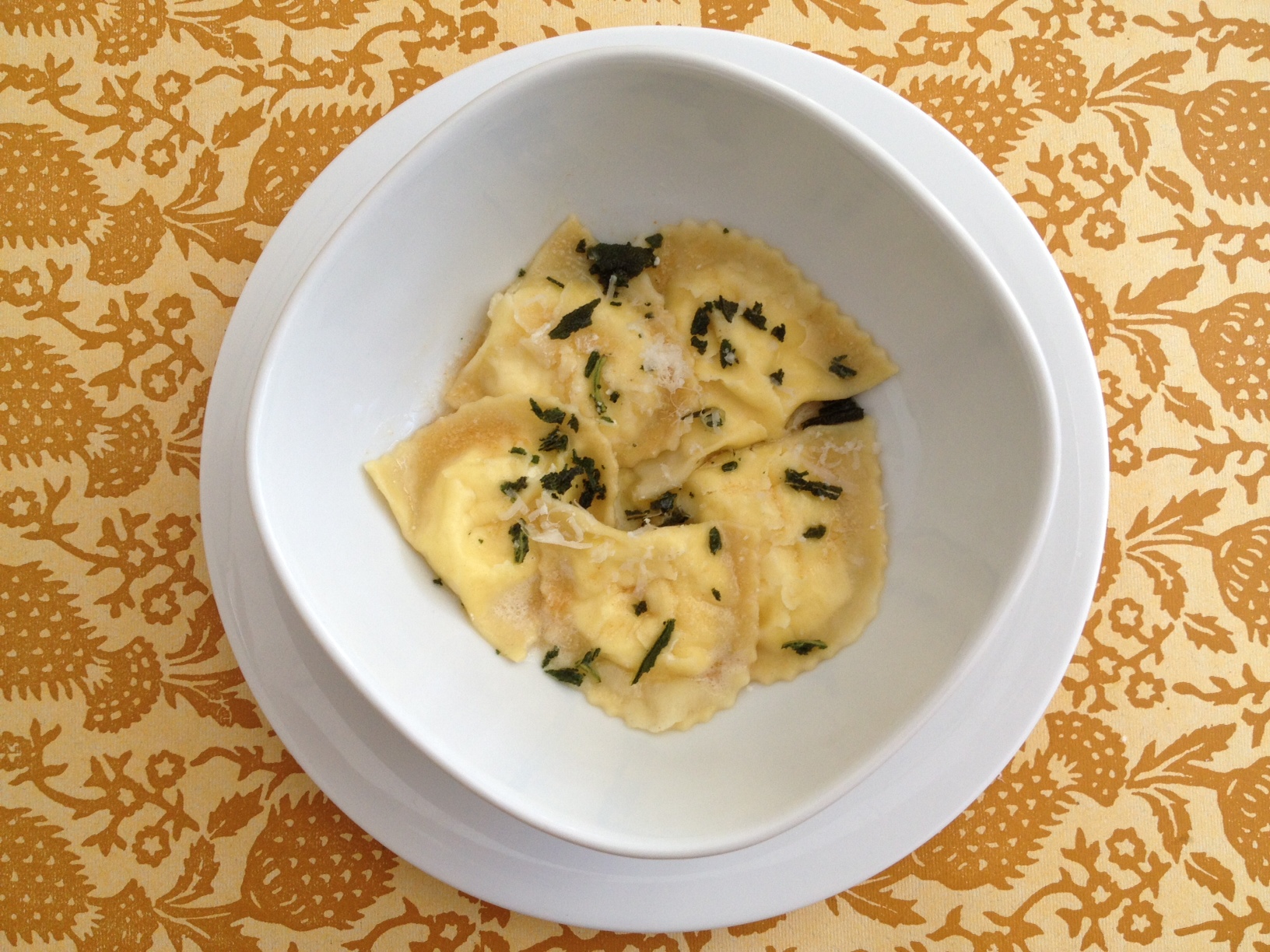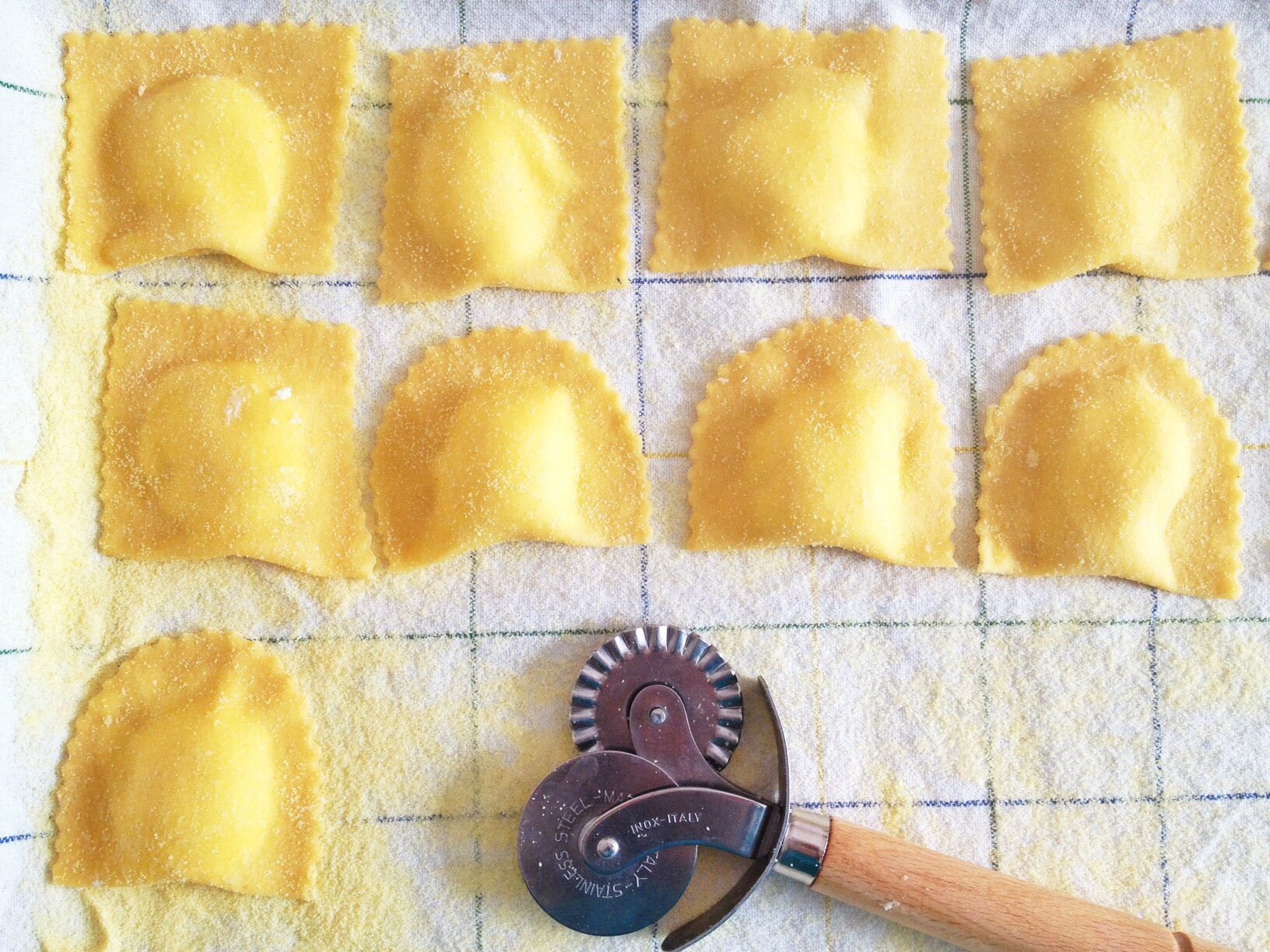Homemade Cheese Ravioli
Do you have a favorite kitchen project? Mine might be making ravioli. I've been doing it for years so this may sound ridiculous, but I still get an enormous sense of accomplishment when I stand back and look at a batch of hand-cut ravioli that I have just made. I straighten the rows in which I have placed them, I scrutinize them to see how each one is different from the next. I count them once, twice, three times. I admire them.
Hand-cut ravioli shouldn’t be rushed. The process requires a certain amount of concentration, of repetition, of contemplation. It's the sort of task in which you can lose yourself, for just a little while, on a winter weekend afternoon. A few years ago, when I was working on The Glorious Pasta of Italy, I bought one of those ravioli molds, a two-piece aluminum and plastic ravioli press that (allegedly) makes quick work of the process, turning out a dozen perfectly shaped square pillows at a time. I've used it exactly twice. For one thing, it did not work as well as advertised; my ravioli clung fast to the mold and had to be banged out. For another, it took away the pleasure of hand cutting.
My hand-shaped ravioli may not symmetrical but their imperfection is what makes them beautiful. These ricotta ravioli are a specialty of Abruzzo. The dough is made from fine "00" pasta flour plus a little semolina, and so is a little rustic. The filling is typically made with fresh sheep's milk ricotta, a ubiquitous ingredient in Abruzzese cooking, but hard to find here in the U.S. Instead I use fresh cow's milk ricotta, which is a softer and little tangier but still makes a tasty filling (make sure to drain it before using).
Ricotta ravioli go well with a variety of sauces. I dressed this particular batch with browned butter and crispy fried sage, but I often use melted butter seasoned with a generous pinch of saffron threads. You can also use simple tomato sauce or a hearty meat sauce. In any case, don't forget a sprinkling of pecorino or parmigiano cheese at serving time.
A few things to keep in mind when you're making homemade ravioli:
Because ravioli are folded over and sealed, the dough needs to be stretched thin so that the finished ravioli aren't too thick. I use my hand-crank pasta machine for this. You should be able to see the shadow of your hand through the ribbon of dough.
Make sure to sprinkle your work surface with semolina to keep the ravioli from sticking. Semolina does a better job than flour of preventing this and is less readily absorbed by the fresh pasta dough.
Use a judicious amount of filling; too much and your ravioli will burst at the seams when you cook them.
Use just a bit of water to moisten the strips of dough before you fold it over the filling. This will keep your ravioli from coming apart during cooking.
Once you have folded the dough over the filling, be sure to press all around to remove any air bubbles. This will help keep the ravioli sealed.
Get yourself a pastry cutter. I love mine because it has two spurs, a straight-edged one and a fluted one. And it's made in Italy
If you are not going to cook your ravioli immediately, place them on a towel-lined baking sheet that has been dusted with semolina and pop them in the freezer. Freeze them until firm, then transfer them to a tightly lidded container and return them to the freezer until it's time to cook them. (I freeze mine even if I'm going to be cooking them later the same day.)
HOMEMADE CHEESE RAVIOLI
Makes 6 servings
Ingredients
1 batch All-Purpose Egg Pasta Dough
1 pound fresh sheep's milk ricotta or cow's milk ricotta, well drained
1/2 cup freshly grated aged pecorino Abruzzese or pecorino Romano
1/2 cup freshly grated Parmigiano-Reggiano
1 large egg, lightly beaten
1/4 teaspoon fine sea salt
Semolina flour, for dusting the work surface and the dough
Instructions
1. Make the pasta dough according to the recipe directions. While the dough is resting, make the filling:
2. In a medium bowl, work the ricotta with a fork until smooth. Stir in the cheeses, egg and salt and mix until thoroughly combined. Cover the bowl with plastic wrap and refrigerate until ready to use.
3. Cover two large rimmed baking sheets with clean kitchen towels and sprinkle the towels with a light coating of semolina flour. Sprinkle your work surface with a light coating of semolina flour as well. Have on hand a fluted pastry wheel for cutting the ravioli, a glass of water for wetting your fingers to seal them, and (optional) a fork for sealing them.
4. Once the ball of pasta dough has rested, cut it into quarters and re-wrap three of the pieces. Using a pasta rolling machine (I use my faithful old hand-crank Atlas), and working notch by notch starting with the widest setting, stretch the first piece of dough to about 1/16 inch thick or slightly thicker (notch #5 or 6 on my machine). The strip should be thin enough for you to see the shadow of your hand behind it, but not so thin that it tears. If the strip of dough becomes too unwieldy, cut it in half crosswise and continue to stretch each piece separately.
5. Carefully lay the strip of pasta on the semolina-dusted work surface. Mound a rounded teaspoonful of filling at 2-inch intervals along the length of the strip, slightly below center. Dip a finger in water and moisten along the bottom edge of the strip and around each mound of filling. Carefully fold the top of the strip, lengthwise, over the filling so that the top edge meets the bottom edge. Press all around the mounds of filling to squeeze out any air and to seal them. Use the fluted spur on a pastry cutter to cut along the bottom edge. Then cut between each mound to create square ravioli. Or, cut around each mound to make a fan shape. Press to seal with your fingers, or use the tines of the fork to seal them. Lay the ricotta ravioli on one of the towel-lined baking sheets. Gather the scraps of dough, put them in a zipper-lock bag and set them aside.
6. Continue to stretch, fill and shape the remaining dough pieces, collecting the scraps as you go. You should end up with 50 to 60 ravioli. If you plan to cook them within the hour, leave the ravioli out. Otherwise, put the baking sheets in the freezer and freeze the ravioli for 1 hour, until solid. Then transfer them to a tightly lidded container and store in the freezer until ready to cook (up to 1 month).
7. (Check the reserved scraps. If they are brittle, discard them. Otherwise knead them and re-roll. Cut into quadrucci, spread out on a semolina-dusted tray and freeze or let them dry (quadrucci dry well). If frozen, transfer to a tightly lidded container and return to the freezer for future use. If dried, transfer to a tightly lidded container and store in the pantry.)
8. To cook the ravioli, bring a large pot of water to a boil over high heat and salt generously. When the water is boiling, carefully drop the ravioli into the pot ~ cook them in batches if necessary to avoid crowding the pot. Cover the pot until the water returns to a boil and then uncover and cook the ravioli for 3 to 5 minutes, until they are just tender (they will be floating on the surface).
9. Scoop up the ravioli, a few at a time, with a large skimmer, taking care to let excess water drain off. Place the ravioli in a warmed serving bowl and spoon heated sauce or melted butter over them (I like melted butter flavored with saffron or sage). Sprinkle a little cheese on top and serve immediately.




